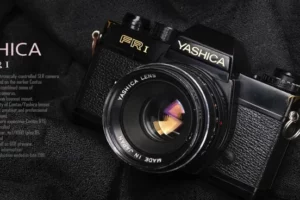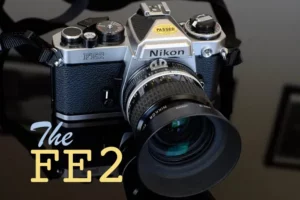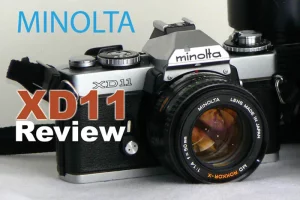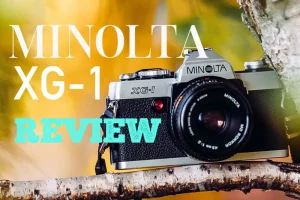Nikon EM Review: A camera made for women?
Last Updated on August 11, 2023
Nikon has always been known as a manufacturer of reliable and robust cameras. But by the late 1970s, robust and reliable was no longer enough. During this time, more must-haves entered the wish lists of amateur photographers. The cameras should be small, light and electronically controlled.
After Nikon had initially overslept the trend, they tried to jump on the bandwagon of small, electronically controlled cameras with the Nikon EM. Finally, in 1979, the Nikon EM was born.
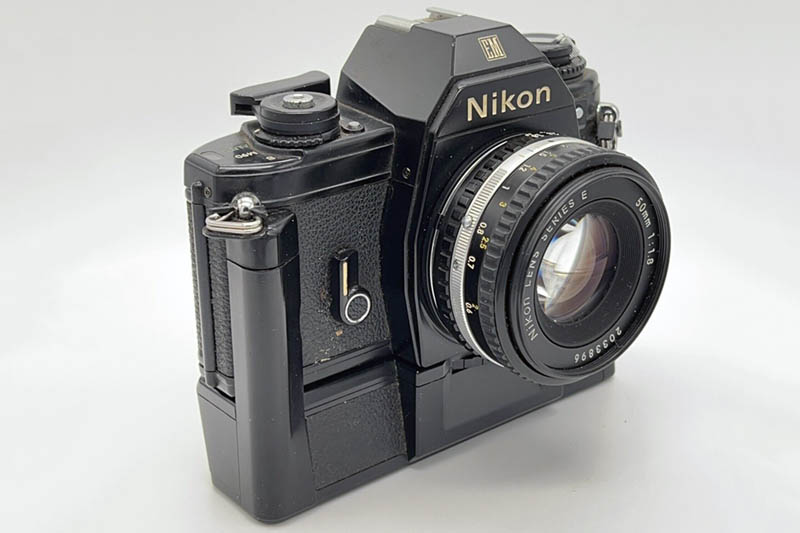
Table of Contents
Nikon EM Specs
| Year release: | 1979 to 1982 |
| Type: | Single Lens Reflex (SLR) |
| Lens mount: | Nikon F bayonet type |
| Shutter speed: | 1 to 1/1000 second, Blulb |
| Shutter type: | Seiko MFC-E focal plane shutter |
| Operation and exposure: | Aperture priority, electronic 60/40 center-weighted |
| Flash sync: | X-sync of 1/90 second |
| Size: | 86 mm (3.4 in) h, 135 mm (5.3 in) w, 54 mm (2.1 in) |
| Weight: | 460 gr. |
History of the Nikon EM
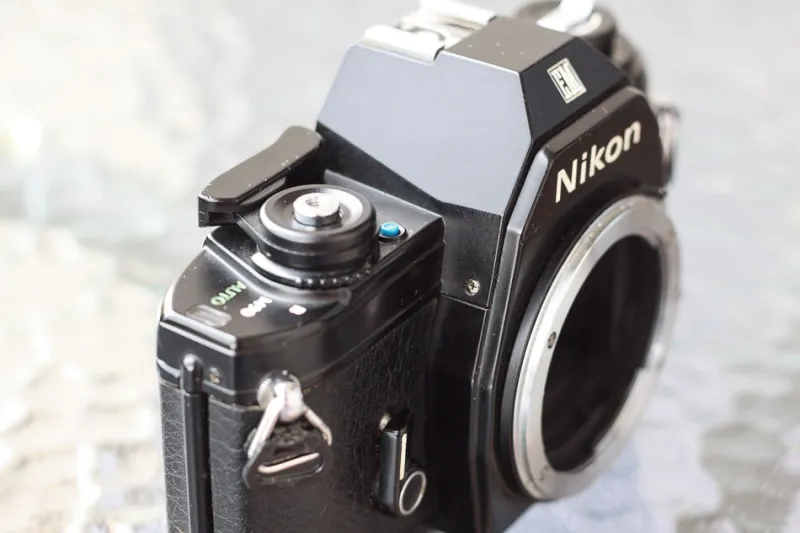
The first electronic cameras, which were still equipped with analogue technology at the time, came onto the market as early as 1965. Around 1975, camera manufacturers were increasingly using digital microcomputers to control camera shutters. Quartz-controlled shutters replaced their analogue predecessors.
With the Nikkormat EL, released in 1965, Nikon also offered the first electronically controlled camera. At just under 800g, it was not a lightweight, but corresponded in weight to the cameras of other manufacturers at the time.
Olympus sets the direction
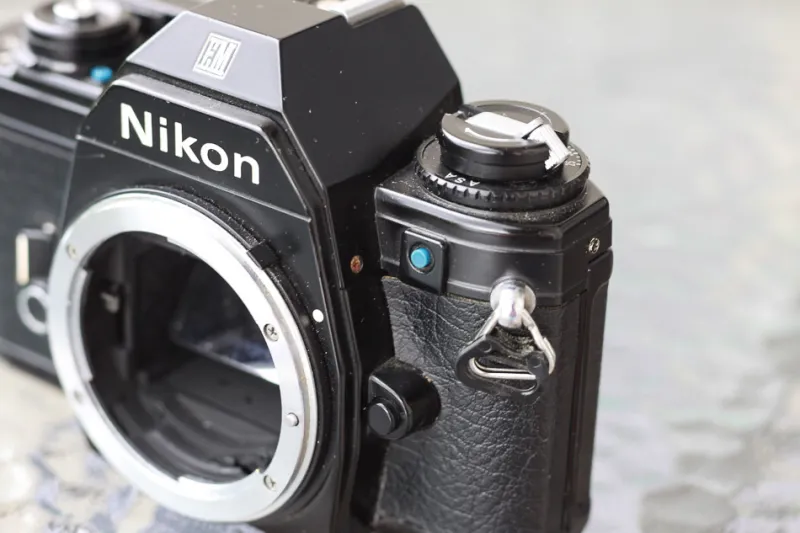
When Olympus came onto the market in 1972 with its M-1, which had to be renamed the OM-1 after Leica intervened, a few things changed.
Many fans of other brands also wanted such a small, light SLR. The OM-1 brought about 500g onto the market, a significant difference to the Nikkormat EL. Other manufacturers followed Olympus and two other classics finally conquered the world in 1976, the Canon AE1 and the Pentax K1000.
Nikon only released the Nikkormat ELW this year, a slightly updated version of the EL. But still far from small and light.
With an eye on the budget

Nikon had to come up with newly designed and developed cameras. The result was the two siblings Nikon FE and FM.
Both resonated with users and are still popular models today. There was still only one problem: Both models were a bit too expensive and customers wanted the same thing, only cheaper. This is how the Nikon EM came about in 1979.
Target group? Or the image of women in the 70s
“Just focus and shoot.” That was an advertising slogan for the Nikon EM in the year it was released. “Affordable and practically foolproof” read another.
On the official Nikon page for the Nikon EM, it is even still referred to as the “SLR Camera for Women”. Is Nikon trying to imply that women can’t or don’t want to use “real cameras”? Who knows.
In my experience, it should be advertised more as “the camera for men”. And that’s where I take my own nose: less concentration on the technical equipment, more on the picture. Something that, in my experience, women can do a little better than us men. But I’m drifting…
The body
It comes completely in black, the Nikon EM. Even if it should become the cheapest alternative among the Nikon cameras, a well-known name was hired as a designer: Giorgetto Giugiaro, designer icon of cars such as the Lotus Esprit, a DeLorean DMC-12 and the first VW Golf.
But he also designed cameras: Nikon F3 and F4, for example, and the Nikon EM.
The controls of the Nikon EM
She already looks beautiful. Professional black with only the essential markings.
Of course, the Nikon lettering catches the eye from the front, as does the EM symbol on the viewfinder. Otherwise, only the self-timer, the mark for attaching the lens and the +2EV backlight button are highlighted in color.
However, why this despicable blue plastic was used for the backlight button remains a mystery. Otherwise, the combination of white and black makes a very good impression. The top has gotten a little more paint.
In addition to the blue battery test button, the red battery status display and the green AUTO label on the mode selector lever, the rewind lever, the shutter release and the other two modes “B” and “M90” also stand out in color.
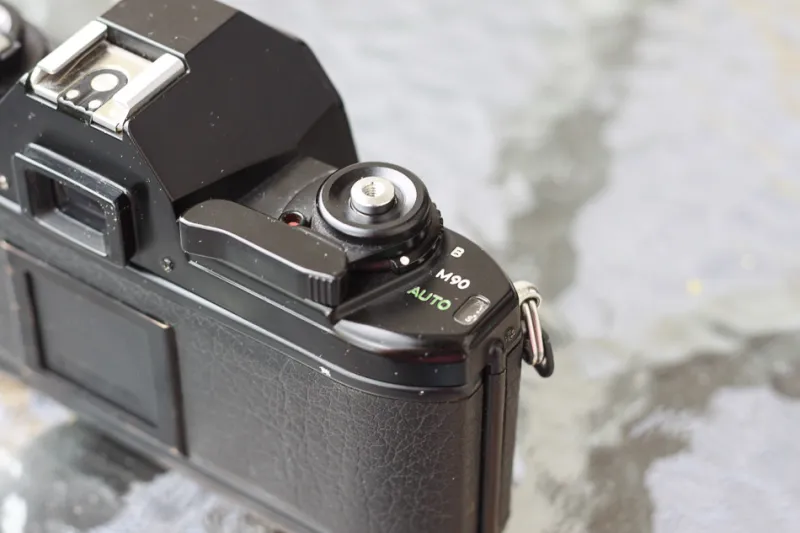
Easy and good
The individual elements are operated according to the usual pattern. Lifting the rewind button opens the back to insert or remove films.
If you lift the ring around the rewind button, you can adjust the film speed. From 25 ASA to 1600 ASA everything is in it. There is comparatively little to adjust on the opposite side. Once you have checked the battery and decided on a mode, usually AUTO, all you have to do is cock and release, nothing more.
True to the motto: suitable for beginners. The clamping lever should be emphasized positively in that it can be folded in and out, depending on whether the camera is being transported or is waiting to be used.
The haptics of the Nikon EM
In the hand, the Nikon EM makes a mixed impression.
I really like the low weight of the camera, provided, of course, that you don’t screw on high-end telephoto zooms or the like. With the usual 50mm or 35mm lenses z. In any case, it lies well balanced in the hand.
The leather covering triggers less tactile pleasures, although one should no longer speak of leather. Plastic with a leather look is better. Well, other manufacturers even take the illusion of leather and have a plastic look from the start.
The budget cuts by the camera manufacturers in the 80s and the coming 90s also cast their shadows here.

Cost savings? Not everywhere
Through mass production and cost savings, a price point that is as attractive as possible should be achieved for the Nikon EM. In stark contrast to this is the development of a completely new winch mechanism.
The design team came up with an entirely new mechanism that required the wind lever to be located between the sprockets, which engage the film’s perforations, and the take-up spool.
The advantage of this construction is that the film can be transported in small steps.
The resulting complex construction was justified with the following sentence from the head of the design team: “I just don’t like cameras that can’t advance the film in small steps.”
It was still the 70s and not the 90s.

The Aperture Priority
Since Nikon has designed a camera with pure aperture preselection with the EM, the display in the viewfinder is only used to check the shutter speed. Further adjustments are then of course made via the aperture on the lens.
Anyone who prefers to take pictures in A mode anyway will feel right at home with operation reduced to the essentials. For everyone else, the camera feels badly cropped. Exceptions to the aperture priority are of course the manual flash sync time and bulb.
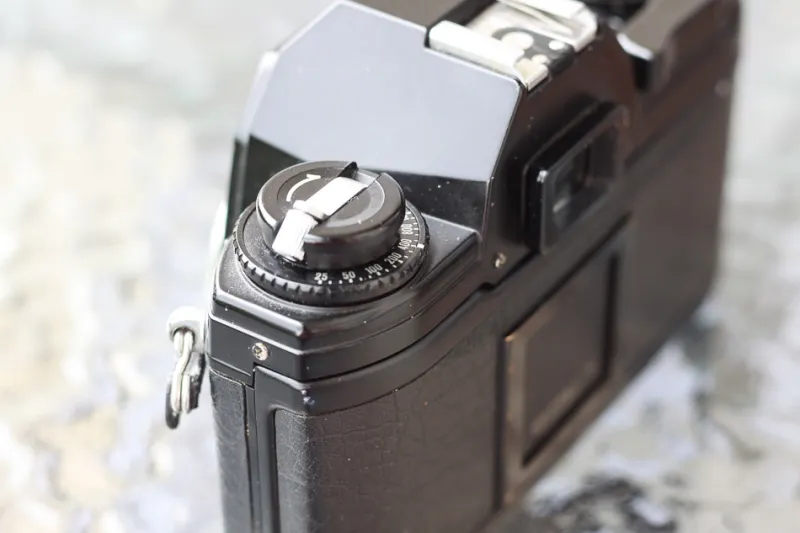
Conclusion on the Nikon EM
Overall, the EM represents Nikon’s foray into the segment of small, lightweight and inexpensive cameras.
If you can live with a somewhat plastic feel and being limited to A mode, you will still find a real Nikon.
Like an F3 or FM3A it can hold the finest F-mount lenses and in the hands of a good photographer it will not disappoint.
If you want a little more Nimbus, don’t go for the Nikon EM. There is a glorious history with the F and its successors. However, you have to dig deeper into your pocket for this.
A Nikon EM in good condition is already available for 30 bucks. It is best for the used buyer to check whether neuralgic points, such as e.g. B. the needle in the viewfinder still work.
For someone looking for a budget-friendly Nikon and settling for the A mode, an absolute recommendation. Everyone else should look elsewhere.

